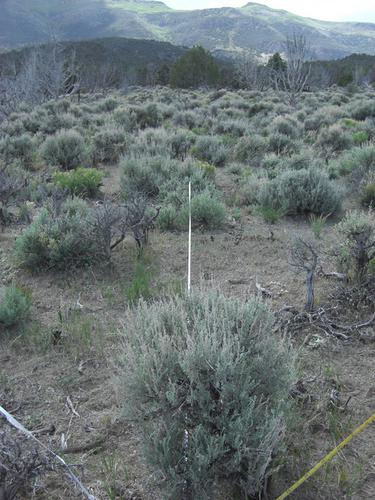当前位置:
X-MOL 学术
›
J. Appl. Ecol.
›
论文详情
Our official English website, www.x-mol.net, welcomes your feedback! (Note: you will need to create a separate account there.)
Episodic occurrence of favourable weather constrains recovery of a cold desert shrubland after fire
Journal of Applied Ecology ( IF 5.7 ) Pub Date : 2021-05-17 , DOI: 10.1111/1365-2664.13911 Alexandra K. Urza 1, 2 , Peter J. Weisberg 2, 3 , David Board 1 , Jeanne C. Chambers 1 , Stanley G. Kitchen 4 , Bruce A. Roundy 5
中文翻译:

有利天气的偶发性限制了火灾后寒冷沙漠灌木地的恢复
更新日期:2021-05-17
Journal of Applied Ecology ( IF 5.7 ) Pub Date : 2021-05-17 , DOI: 10.1111/1365-2664.13911 Alexandra K. Urza 1, 2 , Peter J. Weisberg 2, 3 , David Board 1 , Jeanne C. Chambers 1 , Stanley G. Kitchen 4 , Bruce A. Roundy 5
Affiliation

|
- Key to the long-term resilience of dryland ecosystems is the recovery of foundation plant species following disturbance. In ecosystems with high interannual weather variability, understanding the influence of short-term environmental conditions on establishment of foundation species is essential for identifying vulnerable landscapes and developing restoration strategies. We asked how annual environmental conditions affect post-fire establishment of Artemisia tridentata, a shrub species that dominates landscapes across much of the western United States, and evaluated the influence of episodic establishment on population recovery.
- We collected A. tridentata stem samples from 33 plots in 12 prescribed fire sites that burned 8–11 years before sampling. We determined individual establishment years using annual growth rings. We measured seasonal soil environmental conditions at the study sites and asked if these conditions predicted annual establishment density. We then evaluated whether establishment patterns could be predicted by site-level climate or dominant subspecies. Finally, we tested the effect of the magnitude and frequency of post-fire establishment episodes on long-term population recovery.
- Annual post-fire recruitment of A. tridentata was driven by the episodic availability of spring soil moisture. Annual establishment was highest with wetter spring soils (relative influence [RI] = 19.4%) and later seasonal dry-down (RI = 11.8%) in the year of establishment. Establishment density declined greatly 4 to 5 years after fire (RI = 17.1%). Post-fire establishment patterns were poorly predicted by site-level mean climate (marginal R2 ≤ 0.18) and dominant subspecies (marginal R2 ≤ 0.43).
- Population recovery reflected the magnitude, but not the frequency, of early post-fire establishment pulses. Post-fire A. tridentata density and cover (measured 8–11 years after fire) were more strongly related to the magnitude of the largest establishment pulse than to establishment frequency, suggesting that population recovery may occur with a single favourable establishment year.
- Synthesis and applications. This study demonstrates the importance of episodic periods of favourable weather for long-term plant population recovery following disturbance. Management strategies that increase opportunities for seed availability to coincide with favourable weather conditions, such as retaining unburned patches or repeated seeding treatments, can improve restoration outcomes in high-priority areas.
中文翻译:

有利天气的偶发性限制了火灾后寒冷沙漠灌木地的恢复
- 旱地生态系统长期恢复力的关键是干扰后基础植物物种的恢复。在具有高年际天气变化的生态系统中,了解短期环境条件对基础物种建立的影响对于识别脆弱的景观和制定恢复策略至关重要。我们询问了每年的环境条件如何影响三齿蒿(一种在美国西部大部分地区占主导地位的灌木物种)火灾后的建立,并评估了偶发建立对种群恢复的影响。
- 我们从 12 个指定火灾地点的 33 个地块中收集了A. tridentata茎样本,这些地块在采样前燃烧了 8-11 年。我们使用年轮确定个体成立年份。我们测量了研究地点的季节性土壤环境条件,并询问这些条件是否能预测年度建立密度。然后我们评估了建立模式是否可以通过站点级别的气候或优势亚种来预测。最后,我们测试了火灾后建立事件的幅度和频率对长期人口恢复的影响。
- A. tridentata 的年度火灾后补充是由春季土壤水分的偶发可用性驱动的。春季土壤较湿的春季土壤(相对影响 [RI] = 19.4%)和较晚的季节性干旱(RI = 11.8%)在建立年份的年度建立率最高。火灾后 4 至 5 年,建筑密度大幅下降(RI = 17.1%)。现场水平平均气候(边际R 2 ≤ 0.18)和优势亚种(边际R 2 ≤ 0.43)对火灾后建立模式的预测很差。
- 种群恢复反映了火灾后早期建立脉冲的幅度,但不是频率。火灾后A. tridentata 的密度和覆盖率(在火灾后 8-11 年测量)与最大建立脉冲的幅度比与建立频率的相关性更强,这表明种群恢复可能发生在单一有利的建立年份。
- 合成与应用。这项研究证明了有利天气的间歇期对于干扰后植物种群的长期恢复的重要性。在有利的天气条件下增加种子可用性的管理策略,例如保留未烧毁的斑块或重复播种处理,可以改善高优先区域的恢复结果。



























 京公网安备 11010802027423号
京公网安备 11010802027423号